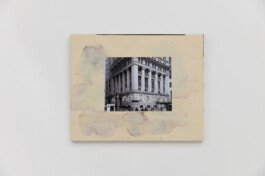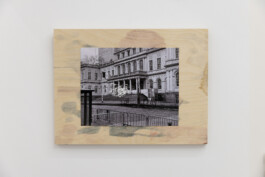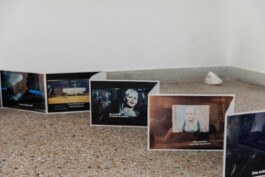






































Maybe We’re Not Alone
2 March 2023 – 8 April 2023
New York based artists Ciccio are exhibiting new sculptures, photographs, and a leporello at Haus N. Ciccio’s artistic practice freely deploys different media, without privileging one over the other to create immersive installations comprising both found and collaboratively produced objects heightened by ventures in photography, painting, collage, and poetry. Ciccio’s interventions in exhibition frameworks are made through particular pairings of work and context.
The show they are debuting renders and frames the architecture of alienation as a response to the predicament of being invited to make an exhibition in a space and location they had never been to before. A common predicament artist’s find themselves in, but one they felt needed to be addressed since context is so important to art’s reception.
From New York they brought a suite of photographs they took of buildings made in the Greek revival style found throughout New York City. These buildings are connected to power: Government buildings, university buildings, churches, banks, The Stock Exchange, and bourgeois nineteenth century homes. They scratched the surface and used spirits to make marks on the photographs resembling images, found online, of paranormal sightings, such as ghosts, and UFO’s. Some of these photographs are framed while others are mounted on wooden panels dyed with drippings from the alcohol used on the photographs.
Scattered across the floor of the gallery there are 70 rocks gathered from around Mount Penteli where the quarry of the stone for the Parthenon was located. It’s also a place where many paranormal sightings have been recorded. These rocks, populating the show, are adorned with cartoonish eyes referring to the pet rock fad of the 1980s described as having “No messes. No allergies. No effort. Just pure, simple solidarity.” Titled Les Citoyens, they evoke a broken system of citizenship.
Sectioning off a small part of the gallery, Water Lillies, is a transparent plexiglass wall covered in remnants of posters found on the street, and held together with just tape. It makes inaccessible that portion of the gallery; making literal the fact that transparency doesn’t mean access, while recalling through the traces of street posters the attempts to claim power in spite of exclusion from it.
And near the back window of the gallery a copy of the top of an Athenian kiosk, covered in marble printed fabrics it resembles an alter used for sacrifices. The word in Greek, Periptero, is also the word for an ancient Greek temple with columns. In Athens many of these cute kiosks were given by the government to disabled veterans after WWI as a way for them to make a living after their service. Originally the kiosks mainly sold newspapers, and now cheap products some of them made in factories far away.
Accompanying these pieces in the center of the gallery a leporello, unfolds along the floor, containing a poem titled We Don’t Have A Life made from a series of subtitles in photographs Ciccio took of themselves watching different movies on their laptops. In the photographs their reflections and the reflections of the rooms they are in can be seen emerging out of the movies on the laptop screen.
In 2018 the New York based Italian artist, Francesco Vizzini, and New York based, American artist, Norman Chernick-Zeitlin, began to sign their work together under the name Ciccio. In Italian, Ciccio means cute and chubby, in Italy it’s a term for a close friend. It’s also the nick name Norman calls Francesco. Norman comes from a background in painting and poetry while Francesco worked as a set designer in Cinecitta in Rome for many years. Ciccio’s work has been been shown at O-Townhouse in Los Angeles and at Galerie Christina Meyer in Munich. They have also shown works in public parks; in Prospect Park, Brooklyn and in Erie Basin Park, Brooklyn as events outside the gallery system. In 2019 they started showing the work of other collaborations in their apartment in Brooklyn Heights. Organizing these exhibitions was a way to build a dialogue with other collaborative practices and to give a space for their friends who haven’t collaborated to experiment with working outside their usual individual artistic practices.




































Maybe We’re Not Alone
2 March 2023 – 8 April 2023
New York based artists Ciccio are exhibiting new sculptures, photographs, and a leporello at Haus N. Ciccio’s artistic practice freely deploys different media, without privileging one over the other to create immersive installations comprising both found and collaboratively produced objects heightened by ventures in photography, painting, collage, and poetry. Ciccio’s interventions in exhibition frameworks are made through particular pairings of work and context.
The show they are debuting renders and frames the architecture of alienation as a response to the predicament of being invited to make an exhibition in a space and location they had never been to before. A common predicament artist’s find themselves in, but one they felt needed to be addressed since context is so important to art’s reception.
From New York they brought a suite of photographs they took of buildings made in the Greek revival style found throughout New York City. These buildings are connected to power: Government buildings, university buildings, churches, banks, The Stock Exchange, and bourgeois nineteenth century homes. They scratched the surface and used spirits to make marks on the photographs resembling images, found online, of paranormal sightings, such as ghosts, and UFO’s. Some of these photographs are framed while others are mounted on wooden panels dyed with drippings from the alcohol used on the photographs.
Scattered across the floor of the gallery there are 70 rocks gathered from around Mount Penteli where the quarry of the stone for the Parthenon was located. It’s also a place where many paranormal sightings have been recorded. These rocks, populating the show, are adorned with cartoonish eyes referring to the pet rock fad of the 1980s described as having “No messes. No allergies. No effort. Just pure, simple solidarity.” Titled Les Citoyens, they evoke a broken system of citizenship.
Sectioning off a small part of the gallery, Water Lillies, is a transparent plexiglass wall covered in remnants of posters found on the street, and held together with just tape. It makes inaccessible that portion of the gallery; making literal the fact that transparency doesn’t mean access, while recalling through the traces of street posters the attempts to claim power in spite of exclusion from it.
And near the back window of the gallery a copy of the top of an Athenian kiosk, covered in marble printed fabrics it resembles an alter used for sacrifices. The word in Greek, Periptero, is also the word for an ancient Greek temple with columns. In Athens many of these cute kiosks were given by the government to disabled veterans after WWI as a way for them to make a living after their service. Originally the kiosks mainly sold newspapers, and now cheap products some of them made in factories far away.
Accompanying these pieces in the center of the gallery a leporello, unfolds along the floor, containing a poem titled We Don’t Have A Life made from a series of subtitles in photographs Ciccio took of themselves watching different movies on their laptops. In the photographs their reflections and the reflections of the rooms they are in can be seen emerging out of the movies on the laptop screen.
In 2018 the New York based Italian artist, Francesco Vizzini, and New York based, American artist, Norman Chernick-Zeitlin, began to sign their work together under the name Ciccio. In Italian, Ciccio means cute and chubby, in Italy it’s a term for a close friend. It’s also the nick name Norman calls Francesco. Norman comes from a background in painting and poetry while Francesco worked as a set designer in Cinecitta in Rome for many years. Ciccio’s work has been been shown at O-Townhouse in Los Angeles and at Galerie Christina Meyer in Munich. They have also shown works in public parks; in Prospect Park, Brooklyn and in Erie Basin Park, Brooklyn as events outside the gallery system. In 2019 they started showing the work of other collaborations in their apartment in Brooklyn Heights. Organizing these exhibitions was a way to build a dialogue with other collaborative practices and to give a space for their friends who haven’t collaborated to experiment with working outside their usual individual artistic practices.
